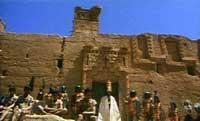 Thanks to upcoming work and family obligations, I don’t know if I’ll have time to catch much more of the Cinematheque‘s Pasolini series; but I did make a point of seeing his Freudian, semi-autobiographical version of Oedipus Rex (1967) last night.
Thanks to upcoming work and family obligations, I don’t know if I’ll have time to catch much more of the Cinematheque‘s Pasolini series; but I did make a point of seeing his Freudian, semi-autobiographical version of Oedipus Rex (1967) last night.
The opening and closing scenes take place in the 20th century, but the bulk of the film, which was shot in Morocco, takes place in some sort of transcultural mythic past. The friend with whom I saw the film said it looked even “more pagan” than it would have seemed if the film had been set in ancient Greece; FWIW, the locales reminded me of the various Bible movies I have seen that were filmed in Morocco, and the tribal cultural elements reminded me of the handful of African films I have seen, particularly Cheick Oumar Sissoko’s Genesis (1999). The creative costuming and set design — the oversized hats in particular — also reminded me of their equivalents in Pasolini’s earlier The Gospel According to St. Matthew (1964), which, in a milder fashion, also shunned strict historical realism in favour of something more imaginative.
Pasolini tells the story in chronological order, and brings things full circle in doing so. But I wonder how the story might have worked if he had adhered to the structure of the original Sophocles play, where most of the story is told in flashback, as it were, while Oedipus tries to deal with a plague that has afflicted his city. I haven’t read Sophocles’ play since university, so I can’t recall what he does with this structure exactly, but it could allow us to begin from a position of seeing Oedipus as a fully integrated member of the community over which he is king, whereas Pasolini’s chronological structure pretty much jumps straight from “Oedipus kills the Sphinx and becomes king of Thebes” to “Oedipus has to deal with the plague that is afflicting Thebes”, and we never really get a chance to see what sort of king he was in the interim.
Ah, but Pasolini didn’t really care about those things; he was more interested in the Freudian subtext and the sexual imagery — as exemplified by those tall, phallic crowns and, as an interesting review here points out, by the oddly-shaped sword that Oedipus uses to kill his father: it, too, has a broad, phallic outline, but it also has a narrow, vaginal slit down the middle. I must admit this reading of the props had not occurred to me while watching the film; I was too distracted by the similarity between these weapons and the similarly slit sword that Jet Li used in Hero (2002)!
Final note: This appears to have been Pasolini’s first feature-length film to be shot in colour, and it looks fantastic. I would definitely like to see Pasolini’s later films, and the big screen would be the ideal venue for them, but, well, I’m getting busy, and I do know the others are all available at the local library and video stores.












